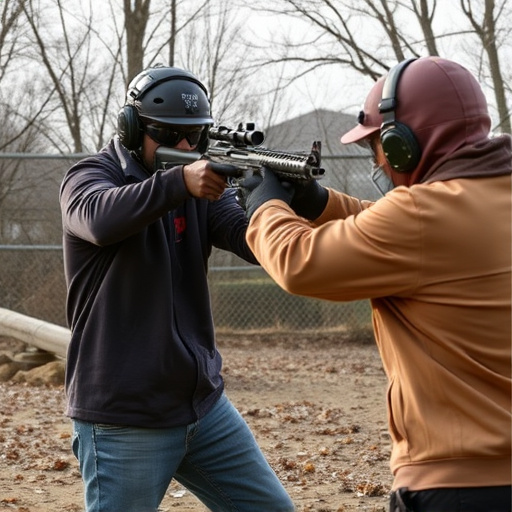Pepper spray, an effective non-lethal tool for dog defense, targets sensitive areas with capsaicin. Proper training and understanding of spray range are crucial. Dogs' respiratory systems make them vulnerable to pepper spray's breathing difficulties. Select 1%-2% capsaicin products designed for dog interactions; check local regulations. Practice short bursts targeting eyes and face during encounters, ensuring accessibility and freshness.
In today’s world, being prepared for potential threats is paramount, especially when facing canine attackers. Pepper spray defense against dogs has emerged as a powerful tool for self-protection. This comprehensive guide explores the effectiveness of pepper spray in neutralizing dog aggressors. We delve into understanding pepper spray, its mode of action, and why certain dog breeds are particularly vulnerable to it. Additionally, we provide insights on choosing the right spray and offer strategic tips for safe and effective usage.
- Understanding Pepper Spray: A Basic Guide
- Why Dogs Are Vulnerable to Aerosol Defenses
- Choosing the Right Pepper Spray for Canine Threats
- Effective Strategies for Using Pepper Spray Against Dogs
Understanding Pepper Spray: A Basic Guide
Pepper spray, a popular defense mechanism against dogs and other potential attackers, is designed to incapacitate temporarily through irritation. It works by targeting the eyes, nose, and respiratory system, making it an effective non-lethal option for self-defense. The active ingredient typically consists of capsaicin, derived from chili peppers, which causes a burning sensation upon contact.
When used in a dog attack scenario, pepper spray creates a defensive barrier, allowing individuals to escape or de-escalate the situation. It’s important to note that proper application is key; aiming for the face and eyes ensures maximum effectiveness while minimizing harm. Regular training and understanding the spray’s range and duration are essential for users to make informed decisions in critical moments.
Why Dogs Are Vulnerable to Aerosol Defenses
Dogs, despite their keen senses and protective instincts, can be particularly vulnerable to aerosol spray defenses due to their sensitive respiratory systems. Pepper spray, a common type of aerosol defense agent, is designed to temporarily disable an attacker by causing intense irritation and pain in the eyes, nose, and throat. For dogs, this can lead to severe breathing difficulties as they struggle to cope with the sudden onslaught of irritants in the air. Unlike humans, who have more developed respiratory control mechanisms, dogs may not be able to effectively avoid or expel the spray particles from their lungs.
Additionally, dogs’ behavior often involves sniffing and exploring their environment, which can increase their exposure to aerosol sprays. They may accidentally inhale the spray or get it into their eyes, leading to panic and disorientation. Their size also makes them more susceptible to direct hits from spray canisters, as they might not be able to quickly dodge or move away from an attacker wielding a spray weapon. Therefore, understanding the unique vulnerabilities of dogs is crucial when considering effective self-defense strategies against these potential threats.
Choosing the Right Pepper Spray for Canine Threats
When considering pepper spray as a defense against canine attackers, it’s crucial to choose a product designed specifically for dog interactions. Standard pepper sprays may not be effective against larger breeds or those with thick coats. Look for formulas that are potent enough to deter aggressive dogs while being safe for use around animals.
The ideal pepper spray for defending against dogs should contain capsaicin in concentrations tailored for animal encounters, typically ranging from 1% to 2%. Consider factors like range and spray pattern; a wide-range spray can cover more ground when facing an approaching dog. Additionally, understanding the legal implications of carrying pepper spray for self-defense is essential, as regulations vary by region.
Effective Strategies for Using Pepper Spray Against Dogs
When facing a dog attacker, a well-timed and effective pepper spray defense can be a game-changer. Here are some key strategies to remember. Firstly, ensure you have a reliable pepper spray specifically designed for animal use, as regular sprays might not have the same impact. Secondly, understand that dogs have sensitive eyes, so aiming for their face, particularly around the nose and eyes, will cause maximum irritation and disorientation.
Practice making quick, short bursts of the spray to avoid blowing it directly onto yourself. The goal is to create a cloud of irritants in the dog’s immediate area to temporarily disable it, allowing you time to escape or summon help. Regularly check the expiration date of your pepper spray and keep it readily accessible for swift deployment when needed.
Aerosol spray defense, particularly pepper spray, offers a crucial tool in protecting against dog attackers. By understanding its mechanics and choosing the right product, individuals can effectively deter and defend against canine threats. Implementing strategic usage techniques ensures safety and control in potentially dangerous situations. Armed with knowledge and the proper pepper spray, folks can navigate encounters with confidence, knowing they have a reliable defense mechanism at their disposal.
